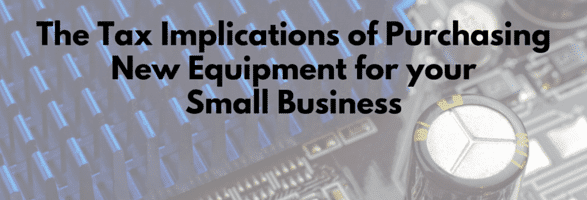Tax Practitioners: Beware Current IRS E-Services Phishing Scam
November 24, 2015Practice Management Forms – 2011
December 9, 2015For most businesses, purchasing equipment is a part of the natural growth process. From computers and servers to vehicles and heavy equipment, businesses generally need equipment to maintain daily operations.
Investing in capital purchases, like new equipment for a small business often has positive tax benefits, but without the right timing and planning, equipment purchases don’t always mean cost savings.
Understanding Deductions and Expenses
Small businesses can usually claim expenses for equipment that can only be used for less than a year. This includes certain hand tools and electronic equipment with a short life. This is usually deducted as “small tools and equipment” expense on a business tax return. Many pieces of equipment with a lifespan that is over one year are classified as capital assets.
Businesses should record capital assets on a balance sheet as equipment, rather than listing them on a profit and loss report. The IRS classifies capital assets in categories based on their lifespans. Small business owners can claim deductions on capital assets through depreciation expense.
The IRS allows small business owners to expense the entire depreciable basis of capital equipment in the year of its purchase, using section 179. Utilizing this deduction eliminates the opportunity to use depreciation for the capital asset in future years.
The Tax Implications of Financing
How a small business chooses to pay for capital equipment can also have an impact on its annual tax bill. Of course, paying for equipment with cash on hand offers convenience, but a small business can still take advantage of tax benefits when leasing or financing equipment. This is even a preferred strategy for many small businesses because it can keep cash flow consistent.
One obvious benefit to leasing or financing capital equipment is that small businesses may be able to deduct the full amount of the purchase without paying the full amount during the tax year. In some cases, the tax savings actually exceeds the payments.
Timing an Equipment Purchase
Timing is crucial when it comes to making small business equipment purchases. The equipment expensing election applies whether equipment was purchased during the first or the last month of a tax year. This means that purchasing a piece of equipment during the last month of a tax year can save money, but only if the equipment is put into use before the year ends. Delaying major equipment purchases until the last half of the tax year is a common practice among small business owners and can be a valuable tax strategy.
State Tax Incentives
State tax laws vary, but in some cases, small businesses can realize tax benefits by reporting capital equipment purchases on their state tax returns. Depending on the industry, certain pieces of capital equipment can qualify for additional state tax incentives.
Discussing the purchase of capital equipment with a financial profession can help small business owners take advantage of the full scope of tax benefits that may be available to them. Numerous options exist for effectively financing, leasing and utilizing cash on hand for capital equipment purchases.
Managing a small business can be challenging and understanding the intricacies of business tax codes is a difficult prospect. Making the most out your tax incentives can ease your burden and save your small business significant cash. Getting advice from experienced financial professionals can make a big impact on your bottom line.
To learn more, schedule your appointment with the tax specialists at Lauzen accounting, and make sure that you take full advantage of all of your equipment purchases.

